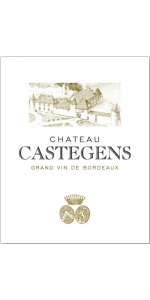Wine from Chateau Castegens

The Château overlooks the Dordogne valley above the village of Castillon-la-Bataille, adjacent to its prestigious neighbour Saint Emilion, only 8 km away. The vineyards are planted on the upper part of predominantly south facing slopes which provide excellent natural drainage and optimum exposure to the sun.
The origins of the estate date back to the early 15th century, not long before the famous battle of Castillon took place in 1453, which ended the Hundred-Years war between the English and the French. With the two other major events that occurred the same year (invention of printing by Gutenberg in Germany, fall of Constantinople in Turkey), most historians consider 1453 to mark the endof the Middle Ages and the beginning of the Renaissance. Highlighting the property’s historical significance, each summer, the estate pays host to the re-enactment of this battle, an epic spectacle with 600 actors and cavaliers.
Château Castegens and its vineyard have been in the same family for 160 years. Curator of the tradition of excellence within the Appellation, the current owner, Baron Jean-Louis de Fontenay, since 1994, has been continuously elected by his peers the Grand Master of the « Confrérie des Chevaliers des Côtes de Castillon ».
Côtes de Bordeaux – Castillon is one of the most ancient wine region in the Bordeaux area,
Area under vine : 28 hectares (estate’s total surface is 120 hectares)
The soil is made of clay and limestone, with an emergence of flint.
The vineyard is planted with 80% Merlot, 18% Cabernet Franc, 2% Cabernet Sauvignon
The average age of the vines : 30 years old - Density : 5000 plants / ha
Viticulture
Leaf thinning on one side, green harvesting on the youngest vines, minimising of environmental impact.
Average yield : 45 hectolitres per hectare
Winemaking
Temperature controlled fermentation, micro-oxygenation, hydraulic vertical wine press.
Ageing : 12 months in French and American oak barrels (a third is renewed each year).
Chateau Castegens Cotes de Bordeaux Castillon is made from 80% Merlot, 18% Cabernet Franc and 2% Cabernet Sauvignon.
The wine boasts an intense, deep and lively red color. The nose offers black fruit, blackberry, cigar box, licorice, some delicate and integrated oak flavors as well. The mouth is full of fruit flavors, spice and fine toasty flavors. The structure is rich, but the tannins are well integrated already. The finish is long and a slight mintiness give the wine a great length and some purity.
Pairs great with meat and vegetables on the grill.
- back
Selected Options
Wineries
Categories
Pricing
Countries
Regions
Grape Types
Wineries
Organic/Free Shipping
Holocene Memorialis Pinot Noir is made from 100 percent Pinot Noir.
Holocene Pinot Noir Memorialis is a blend of 777, Pommard and 115 clones from MonksGate vineyard in the Yamhill-Carlton AVA, and it saw about 20% new French oak for 16 months prior to bottling. It is always the lighter and more feminine of the two Holocene wines, with red fruits, white flowers, dried herbs, mushroom and forest floor aromatics, bright acidity and a lithe texture, long finish.
By now, everyone knows that the Willamette Valley is an amazing place to grow Pinot Noir. When I relocated from Napa Valley to partner up with Force Majeure Vineyards, I knew I also wanted to start a project where I could focus attention on a varietal and growing region that I loved. Part of the excitement of being in the Pacific Northwest is the ability to have access to so many amazing vineyards and so much diversity, along with the opportunity to push boundaries and try new things – something that is becoming increasingly difficult in other growing regions.
We partner up with a few very small, diverse and amazing vineyards in the Willamette Valley, sourcing fruit from these dry-farmed sites that emphasize low yields, sustainable practices and produce outstanding fruit.
The wines are crafted in the same way I have been making wine since I was carrying it out at Bryant Family Vineyard in the Napa Valley — utilizing very low-impact, non-industrial techniques, native yeasts, little extraction and little new oak, and never filtering or fining. This allows a real sense of place to show through in the wines that is often dimmed when too much manipulation is undertaken.
Our first vintage was 2015, and was released in early 2017. As production is currently extremely small, the best way to get the wines into your hands is to join our mailing list at the “Mailing List” link above to receive an allocation when we have a release. We release wines once per year, and they will be sold on a first come, first served basis, shipped straight to your door.
Review:
"A Bing cherry aroma slinks its way up from the glass, followed by spicy whispers of cardamom and cinnamon. Straw and chalkboard dust scents seal the deal. After a tannic black tea note materializes on the palate, the wine's cranberry and raspberry flavors punch the tart button. You can feel the tannins, but they aren't grippy. The acidity, however, lets you know it is ready for juicy business. Memorialis is quietly becoming one of Oregon's best Pinot Noirs. — Michael ALBERTYS"
- - Wine Enthusiast (October 1st 2025), 98 pts & Editor's Choice





